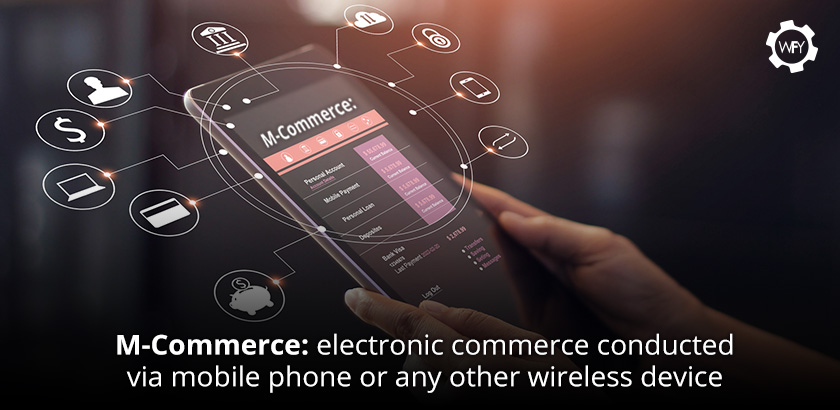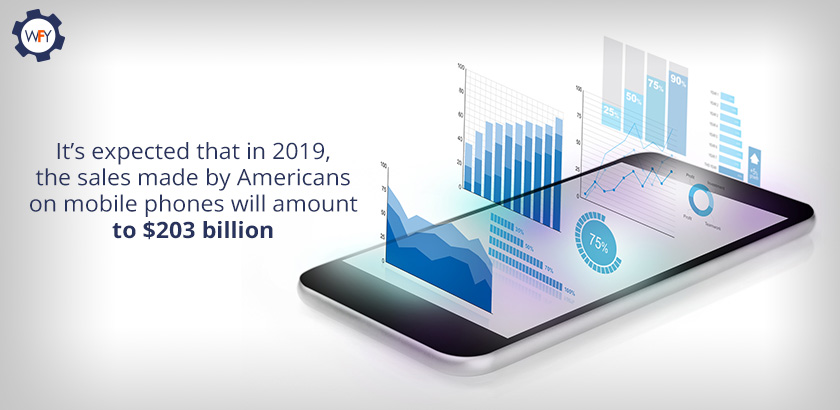M-Commerce in 2019: More Users Will Make Purchases Via Mobile This Year
5 min read
May 10, 2019
 We have talked about many of the ways in which the Internet and the digital evolution have improved people's lives. When it comes to consumer buying habits around the world, both of these elements have reduced the required steps to make purchases to a single click. Thanks to the digital evolution, ecommerce is on the rise and, for active Internet users, this shopping method represents a quick and simple alternative to leaving the house and going to the store.
We have talked about many of the ways in which the Internet and the digital evolution have improved people's lives. When it comes to consumer buying habits around the world, both of these elements have reduced the required steps to make purchases to a single click. Thanks to the digital evolution, ecommerce is on the rise and, for active Internet users, this shopping method represents a quick and simple alternative to leaving the house and going to the store.Everything indicates that, amongst all devices available to make online purchases (tablets, desktops, laptops, smartphones), users have shown a stronger preference towards smartphones making way for a new concept known as m-commerce.
What is M-Commerce?
 Similar to the birth of the term ecommerce and its unstoppable evolution and worldwide acceptance, the word m-commerce comes from an abbreviation, this time of the term Mobile Commerce, and while it's comparatively not as developed, the growth of its influence in the digital world is still worth noting. M-commerce is a form of electronic commerce supported by mobile phones or other wireless devices like tablets. Purchases can be made on a browser or an app, allowing easy access to online stores with the use of mobile phones.
Similar to the birth of the term ecommerce and its unstoppable evolution and worldwide acceptance, the word m-commerce comes from an abbreviation, this time of the term Mobile Commerce, and while it's comparatively not as developed, the growth of its influence in the digital world is still worth noting. M-commerce is a form of electronic commerce supported by mobile phones or other wireless devices like tablets. Purchases can be made on a browser or an app, allowing easy access to online stores with the use of mobile phones.The preference for mobile devices when it comes to online shopping is a trend that continues to grow; according to the report released by Global Digital Statshot, by October 2018, 57% of the world population was already using mobile devices to go online, a percentage that greatly surpassed the 22% reached by desktop or tablets.
The same report states that the number of people that use smartphones to stay active on the Internet is currently at 5 billion users. This, along with other factors, shows that m-commerce is a reality that, if statistics are to be trusted, will truly blossom into one of the most popular forms of online shopping in the course of this year.
Other Popular Blog Posts
M-Commerce in 2019: American Users Will Increase those Purchases Made Via Mobile
 From a less global perspective, even though in the USA desktops are used more for online purchases, their growth hasn't been as great as that of the smartphone. In fact, according to a study performed by eMarketer, the annual increase of desktop purchases has been only 5%, despite reaching $331 billion in 2019.
From a less global perspective, even though in the USA desktops are used more for online purchases, their growth hasn't been as great as that of the smartphone. In fact, according to a study performed by eMarketer, the annual increase of desktop purchases has been only 5%, despite reaching $331 billion in 2019.Meanwhile, m-commerce will represent 34% of ecommerce sales made in the US this year, and it is expected that sales made by Americans on mobile phones will amount to $203 billion in 2019.
Who is responsible for this boost in mobile device usage? To provide more information on the rise of m-commerce, the study showed that 61% of users between 18 and 34 years of age (millennials) take the lead when it comes to using mobile apps to buy products or services. For more information regarding millennials and their online behavior see our blog post: Which is the Largest Generation in the US and the Biggest Influence on Digital Marketing.
Why are These Numbers so Important?
A strong and constant online presence must be a priority for your company when you decide to have a website. As such, you must be aware that m-commerce is the leading trend in online shopping. This is important in order to understand what the future brings. It's also valuable for determining the best way to maximize your company's online presence.Knowing that the growth of m-ecommerce is increasing quickly, it's time to ensure your business website is constructed in a way to maximize mobile usability and experience. For this, your website must have an SEO Web Design and employ responsive technology. SEO means Search Engine Optimization and SEO Web Design means having a web design constructed for SEO and one of the key factors is responsive technology.
What is SEO Web Design and Responsive Technology? How Can They Help Me Succeed in the M-Commerce World?
 An SEO Web Design is a web design that is code and image optimized. When viewing a website, what allows you to see it is the underlying HTML, CSS and Javascript code. It's like a car, what allows it to run is the engine, mechanical intricacies, wiring, and tires. But with SEO, your car now needs to be an optimized car because you are competing against tens, hundreds or even thousands of competitors for the premium positions in the search engine results – spots 1, 2, and 3. Think of it like NASCAR. You can't expect to win a NASCAR race with a standard Honda Accord or Ford Focus, cars that look nice but are not optimized at the technical level to compete in NASCAR. So why would you think you can compete and "win" the SEO race with a standard website or web design? You just can't. And by "win" we mean maximizing your visibility within search engines to maximize leads and sales. There are many website builders or design templates on the Internet, or possibly you developed a website and someone programmed it for you, but these three options for web design have one thing in common...they are not SEO optimized at the code level, and therefore most of them score poorly with Google's Page Insight Tools, which you need to score well on if you want maximize your visiblity, leads and sales.
An SEO Web Design is a web design that is code and image optimized. When viewing a website, what allows you to see it is the underlying HTML, CSS and Javascript code. It's like a car, what allows it to run is the engine, mechanical intricacies, wiring, and tires. But with SEO, your car now needs to be an optimized car because you are competing against tens, hundreds or even thousands of competitors for the premium positions in the search engine results – spots 1, 2, and 3. Think of it like NASCAR. You can't expect to win a NASCAR race with a standard Honda Accord or Ford Focus, cars that look nice but are not optimized at the technical level to compete in NASCAR. So why would you think you can compete and "win" the SEO race with a standard website or web design? You just can't. And by "win" we mean maximizing your visibility within search engines to maximize leads and sales. There are many website builders or design templates on the Internet, or possibly you developed a website and someone programmed it for you, but these three options for web design have one thing in common...they are not SEO optimized at the code level, and therefore most of them score poorly with Google's Page Insight Tools, which you need to score well on if you want maximize your visiblity, leads and sales.
Recent Blog Posts
As stated above, one of the important elements of SEO Web Design is employing responsive technology which is what makes a website "fluid", meaning the ability to modify its layout or display to the device (mobile, tablet, laptop, desktop, television) viewing it. Today, each of these five devices come in various sizes and resolution settings, which means you must employ a technology capable of modifying the display in a fluid fashion for these myriad of scenarios, and this is precisely what responsive technology does. However, with SEO Web Design, the responsive technology used should be one that maintains or allows for code optimizations. The most widely used responsive technology is Bootstrap which is an open-source, front-end component library, however its standard implementation falls short of true SEO code optimizations and the design fluidness is often less than optimal, and both of these scenarios can affect overall user experience which then affects your search engine rankings, conversion rates, repeat visitors, the average session time per user, bounce rates, and the likelihood that the user will recommend your website to a friend. Since bootstrap is open-source you can make modifications, however who has the time to do that? Luckily, there is a more optimal solution - it's called WebFindYou Responsive Technology and it comes standard with WebFindYou.
WebFindYou, the All-In-One Digital Marketing Technology, Helps you Maximize the Power of M-Commerce
 WebFindYou understands the importance of m-commerce and the task ahead of all companies trying to keep up with the changing tendencies on the Internet. Since 2015, one of Google's primary requirements is a mobile-friendly web design. The more you adapt to the norms set by the most popular search engines, the easier it will be for your website to rank at the top of search results and for you to increase your companies leads and sales.
WebFindYou understands the importance of m-commerce and the task ahead of all companies trying to keep up with the changing tendencies on the Internet. Since 2015, one of Google's primary requirements is a mobile-friendly web design. The more you adapt to the norms set by the most popular search engines, the easier it will be for your website to rank at the top of search results and for you to increase your companies leads and sales.Google aims for a safer and faster Internet experience. Your website's design must adhere to the fundamental principles of SEO, like optimized web design for mobile and tablet devices, responsive technology, image optimization, fast load times, a secure website via the installation of an SSL certificate, and an optimal user experience.
This is why WebFindYou engineered a superior responsive technology to that of Bootstrap, one that is light weight, SEO code optimized, improved fluidness and visualization on all devices, all of which will help maximize user experience, increase average session duration, decrease bounce rates, increase repeat visits, decrease website load times, and help improve a website's search engine rankings.
WebFindYou also contains ecommerce and shopping cart technology, meaning you can quickly and easily sell products and services via your website and do so knowing you'll be using a technology optimized for m-commerce.
Are you ready to discover the True Power of the Internet and maximize digital marketing revenues with WebFindYou? Simply follow these easy to follow steps to get started:
- Click here to purchase WebFindYou.
- You'll receive an email to access the WebFindYou platform for your website.
- Follow the very easy to follow videos to implement WebFindYou for your business.
For questions, please call us at 866-SEO-WEBS, fill out our contact form, subscribe to our newsletter or follow us on social media to stay informed of everything WebFindYou including webinars and live speaking events.

If you found this article helpful then let us know in the comments section below. Likewise, feel free to share it using the share options below. Want us to cover another topic of your interest pertaining to digital marketing? If so, then like us and follow us on social media, and post to any of our social media profiles the topic you'd like us to discuss: Facebook WebFindYou, Instagram @WebFindYou and Twitter @WebFindYou.










